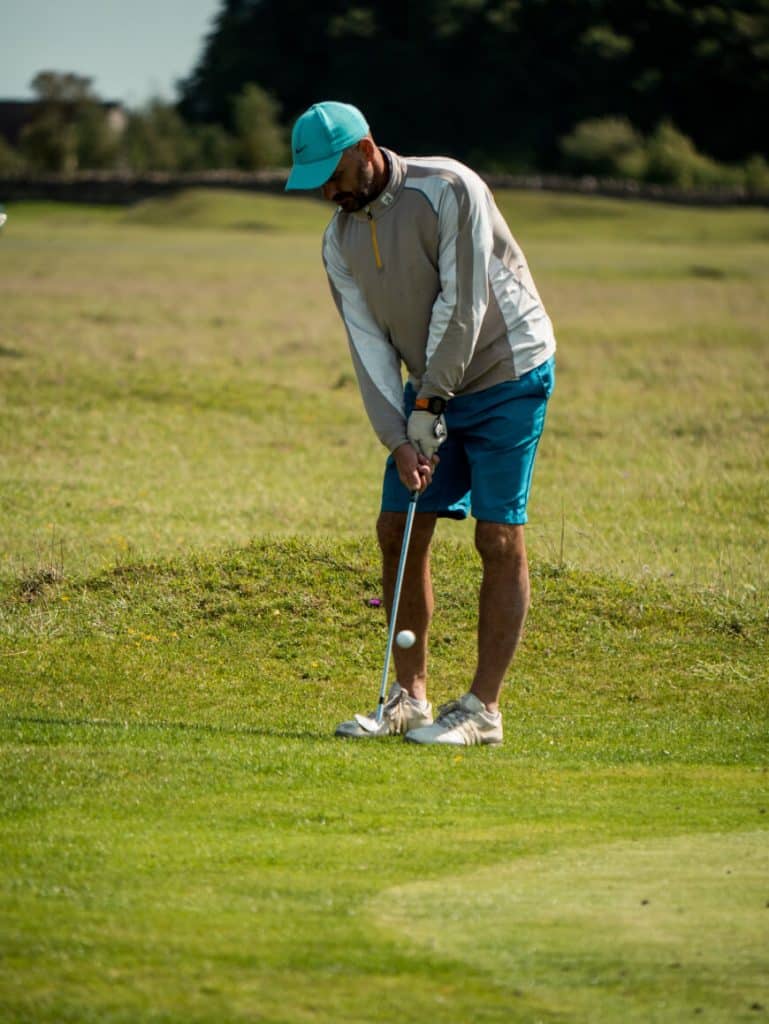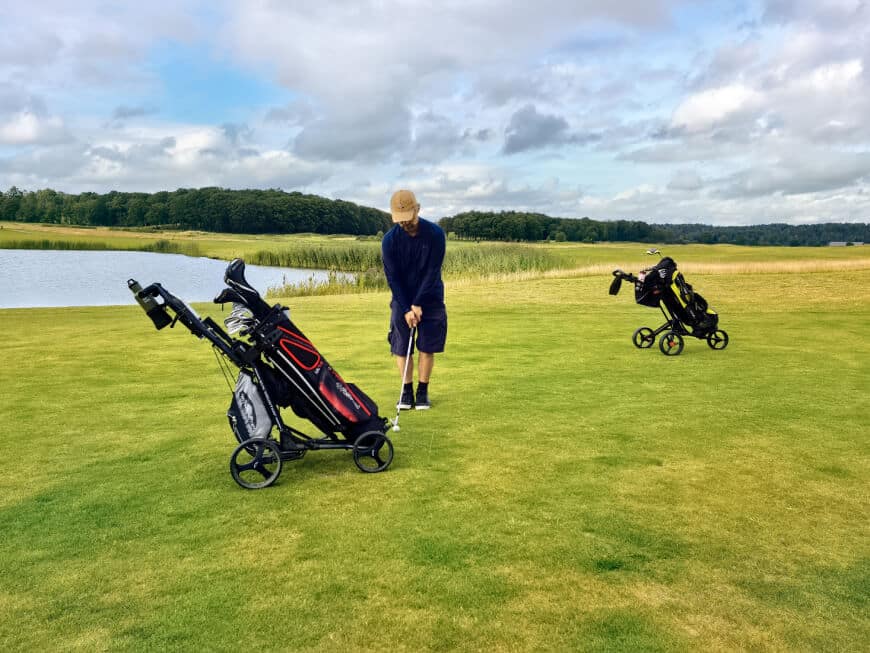Chipping is a golf shot all golfers want to master. Why?
Chipping is a shot that takes you closer to the pin and one of the shots to have a good score. It is a simple low shot that gives the ball a little time in the air. The shot does not need a great swing speed to carry the ball far into the air. The shot only needs a solid contact.
But what is the best golf club to use to execute chipping the way you want it to be?
In this article, we will tell you what club to use for chipping to get the shot right.
What Club To Use For Chipping?

The best clubs to use when chipping are the wedges. It is one of the rules of the thumb that you can use a pitching wedge, sand wedge, gap wedge, and lob wedge when chipping. Here are some possible effects of each wedge when chipping.
1. The Pitching Wedge
The pitching wedge (PW) usually has a loft between 46 and 50 degrees. The PW is usable for a full-swing approach shot into the green. When approaching the green, the pitching wedge is more reliable on small bumps.
The pitching wedge is also better on a run-type shot when close to the green. Once the ball lands, expect it to roll a little further.
2. The Gap Wedge
The gap wedge (GW) golf clubs have lofts between 50 and 54 degrees. The GW, as its name implies, fills the gap between the PW and the SW. It is also called the utility wedge or the approach wedge.
The gap wedge is more efficient to use within the green and for full shots. Many golfers utilize the GW to get out from a bunker further from the green.
3. The Sand Wedge
A good sand wedge (SW) loft varies from 54 to 58 degrees. It is one of the best wedges for chipping. Using the sand wedge, you can let the ball airborne and land closer to the flagstick. However, expect the ball to roll a few feet from the pin.
The sand wedge is also ideal to use from the rough, sand, and grass.
4. The Lob Wedge
The lob wedge also called the L-wedge or lofted wedge, typically comes with a loft from 58 to 64 degrees. More experienced golfers consider this club the one to use for chipping. They also use an LW when hitting on greenside bunkers while the flagstick is not far away.
How Do I Choose The Right Club For Chipping?

Many golfers prefer to carry two wedges among the four wedges we discussed. But many also bring with them all four wedges. Here are the factors to consider in picking the proper chipping club.
Golf Ball’s Lie
Do not use a lob wedge in chipping if the grass is too long. The gap wedge may be a clever idea.
Distance to the Hole
Chipping short distances from the green using sand or lob wedge is a good idea. The higher lofts of the clubs give faster swing with enough spin on shots allowing efficient hits on short distances.
Firmness of the Green
On the harder ground, the pitching wedge or a sand wedge is ideal. Hard greens may compare to cement flooring, where the ball bounces higher when using high lofted clubs. The golf ball could also roll directly to the green when hitting it with a higher loft.
Obstacles & Traps in Your Way
High loft clubs may take you out of ditches, hazards, trees, and other obstacles in your sight. The lob or sand wedges might do the trick! These clubs give you enough spin to keep you on the right track to the dance floor (putting green).
The Rub of the Green
It sometimes boils down to where you could achieve the perfect chipping by trying out different clubs you frequently use. For example, your 7-iron might help you consistently chip to cover the 10-15 yards on the green.
The Right Way To Chip

Chipping looks too easy when seeing more experienced golfers do it in front of you. But if you struggle to do it yourself, maybe you need a lot of practice. Using a simulator might also help. Here are some of the best ways to chip.
1. Control Low Point
You can have a solid chip shot when you hit the perfect low-point spot on your strike. To achieve this, aim the club face on the ball or a little bit in front of it. This way, you hit first the golf ball before hitting the turf and not the other way around.
2. Leveling Your Shoulders
The shoulders should stay level when pitching or chipping on the downswing. This way, you hit the ball first before the club strikes the ground. For a basic chip, use a 52- to 56-degree wedge if you want a little closer to the flagstick
3. Fold and Unfold Swing
In achieving a crisp shot on the golf ball, the fold and unfold swing strike is effective for chipping. You can do a good downswing when you fold your right arm while pivoting the left wrist.
Tips For Excellent Chipping

1. Practice, Practice
Practice makes perfect, so they say. During drills, you can use the wedges available to you. From there, you can figure out what loft of wedge you excel in. One of the best practice drills is aiming at a target at least 20 yards away.
2. Watch the Changing of Your Pace
Pacing is a crucial element in making chip shots more effective. Try not to do the chip shot in a rush. Take it all calmly with a deep breath to keep your mind and body more relaxed.
3. Use the Bounce
Using the bounce when chipping is a clever idea! To make this technique work, glide underneath the ball and make solid contact, just like the slip ‘n slide hit.
4. Make Sure your Next Shot is a Putt
A chip shot may bring you far or closer to a putt shot. Once you master chip shots through practice and the correct club, ensure that your next move will be a putt.
5. Buy a 60-Degree Wedge
Yes, buying or owning a 60-degree wedge is not only great for chip shots. The 60- degree wedge has the lowest bounce. It allows a golfer to do a full swing and pop the ball higher. Consequently, it rolls the ball a little after hitting the ground.
6. Keep It Simple
Yes, do chipping as simply as you can. Do it in your natural stance and without aggressive behavior when swinging.
What You Can Do Today to Get Better
Practice, practice, and do more practice!
FAQ’s
1. What wedge is best for chipping?
The lob wedges are the best clubs to utilize when doing chip shots. It is a general rule that many golfers consider. But in more instances, other golfers like us use a sand wedge or a gap wedge when needed.
2. What club to use chipping around the green?
One of the most sought-after clubs for chipping around the green is the Cleveland Golf- RTX ZipCore Tour Satin Wedge. The Wilson Harmonized Golf Wedge comes close.
3. Should you use one club for chipping?
A more recommendable approach for chipping is using the four wedges. But as we stated, there are only 14 clubs allowed in your bag, carrying more wedges may not be practical. However, average golfers will find relief in a gap wedge as their primary tool in consistently hitting chip shots.
Ideally, using the four wedges increases your possibility of making different chip shots. It will make a lot of difference in your scores.
4. Is it better to chip with a 56 or a 60-degree wedge?
As a rule of thumb, it is much easy for average golfers to chip on a 56-degree wedge than a 60-degree wedge.
5. What club to use for pitching?
High lofted clubs like the 54, 56, 58, or 60-degree utility wedges are ideal for pitching.
6. What club to use on the fringe?
When hitting on tight and thick fringe lies, you can use a 6-iron or a pitching wedge.
Conclusion
Do you want to become a better chipper? If you are wondering what club to use for chipping, pick something that suits your play and your experience level.
Many average golfers consider the 52- to 56-degree wedge the ideal club for chipping. Moreover, pitching and gap wedges are also good starting points for average golfers for consistent chipping in the green.
Better golfers are advised to use a 58- to 60-degree loft for more consistent chipping.
Read more:
- Are Chippers Legal In Golf? When Is A Chipper Ideal To Use?
- Sand Wedge Bounce: 10 or 14.Which Is Best For You?
Matt Stevens is the founder of Golfrough.com. He holds a Postgraduate in Sports Marketing and has played golf since he was four years old. Having experienced every high and low golf has to offer, his writing helps the average golfer avoid the mistakes he has made in 28-years on the course.

